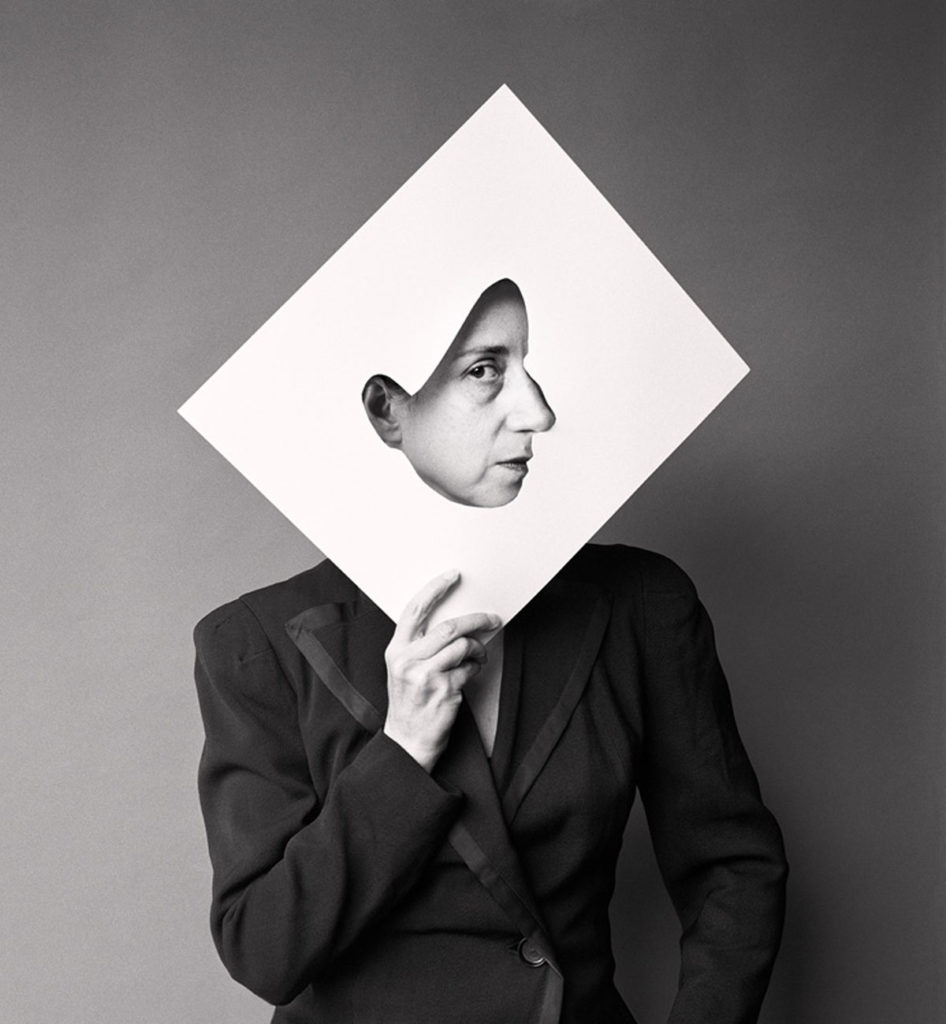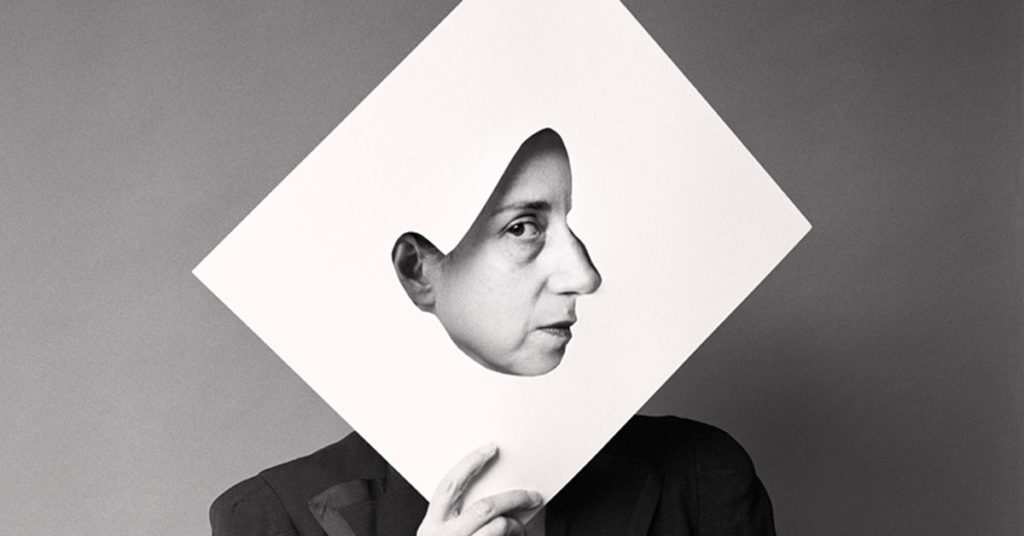 Unknown photographer. Natalie Brettschneider performs Profile Mask, c. 1952. Archival ink jet print from original negative. Carol Sawyer/Natalie Brettschneider Archive. Acquired with the assistance of Kathleen Taylor, 2015.
Unknown photographer. Natalie Brettschneider performs Profile Mask, c. 1952. Archival ink jet print from original negative. Carol Sawyer/Natalie Brettschneider Archive. Acquired with the assistance of Kathleen Taylor, 2015.
Every so often an article recounting the story of Baroness Elsa von Freytag-Loringhoven, said by some to be the originator of Fountain, credited to Marcel Duchamp, goes viral and circulates across social networks. These articles generally work from a body of evidence that convincingly suggests that Freytag-Loringhoven is at least partially responsible for the famous urinal. Yet the history of Modernism is so deeply entrenched that as the stories come and go, the possibility of a narrative of 20th-century art not sprung from the origin of Duchamp remains foreclosed.
Since the 1990s, a major project of art history and its most public arm, the museum exhibition, has been to revise such resilient narratives. These projects are numerous and take many forms: from large-scale survey exhibitions devoted to periods, styles and movements, to exhibitions focusing on a single neglected aspect or moment in an artist’s career; from exhuming little-known artists or works, to recasting extremely well-known ones in new social, historical or theoretical contexts. As a genre, which it surely now is, revisionist exhibitions foreground the scholarly research that goes into them and trade on the museum’s didactic function, usually supplementing artworks with in-depth texts that narrate curatorial decisions as components of an explicit historiographic argument, if not a polemic. Large survey exhibitions of this sort also usually feature a substantial exhibition catalogue conceived to double as a new textbook, literally replacing old, obsolete narratives.
As I write, the Art Gallery of Ontario has just taken down its staging of “Florine Stettheimer: Painting Poetry”, an exhibition that asks us to rediscover—not for the first time—another Duchamp-adjacent woman artist. The exhibition’s premise is characteristic of one major kind of revisionist exhibition: one which inserts minor—or in some cases totally obscured or overlooked—figures into leading roles in art history, with the larger and often unrealized goal of upheaving art-historical master narratives and the plot devices on which they rely. One especially influential early exhibition in this vein was “Inside the Visible: An Elliptical Traverse of the 20th Century in, of and from the Feminine,” curated by Catherine de Zegher at the Institute of Contemporary Art in Boston in 1996. This exhibition, devoted solely to “under-recognized contributions by women artists” to the historical arc of 20th-century art, significantly raised the profile of several now-central figures, such as Lygia Clark and Hannah Höch, while contributing to the increased status of others, such as Claude Cahun, Katarzyna Kobro and Sophie Taeuber-Arp.
A second type of revisionist exhibition proceeds from a methodological break with influence and style (the precedence of, say, Florence, Paris and New York, whose aesthetic innovations filter out to other geographic regions), and is expressed through an explicit critique of centre-margin hierarchies in favour of the writing of horizontal, networked art histories. Here, decentred constellations of activity replace “seminal” originary acts. For example, the enormous “Dada” exhibition that toured the National Gallery of Art, Centre Pompidou and MoMA in 2005 and 2006 focused on the movement’s self-proclaimed internationalism and organized its account across multiple, overlapping centres—Zürich, Berlin, Hanover, Cologne, New York and Paris. Breaking with the usual characterization of Dada as a movement defined by the shocking works of a handful of male artists, the exhibition stressed the collaborative nature of Dada, both in terms of the production of individual works and, more significantly, the exchanging of ideas through its international, albeit here mostly Western European, network.
A revision to this revisionist account appeared almost immediately. Art historian Tom Sandqvist’s 2006 monograph Dada East: The Romanians of Cabaret Voltaire expanded the geographic purview of the MoMA exhibition’s narrative by establishing East-Central Europe as a site of proto-Dadaist activity for several of the movement’s key figures. A decade later, the Dada centenary revealed the continued currency of these stakes: the Kunsthaus Zürich staged “Dadaglobe Reconstructed,” a new exhibition (which later toured to MoMA) on Dada’s global networks based on Tristan Tzara’s never-realized anthology on Dada’s internationalism, while “Dada Afrika: Dialogue with the Other” at the Museum Rietberg, also in Zürich, offered a postcolonial corrective to the horizontal Dada.
Canada does not appear anywhere in these global histories of Dada. However, Natalie Brettschneider, the fictional protagonist in a long-running project by Vancouver-based artist Carol Sawyer, would have fit plausibly as the token Canadian in “Dadaglobe Reconstructed,” if she were real. “The Natalie Brettschneider Archive,” a recently closed exhibition at the Vancouver Art Gallery, cannily invokes the tropes of both kinds of revisionist exhibitions—ones which rewrite history with minor figures in major roles, and ones which change the objects of art history by privileging networks over individual artists. In fact, Sawyer’s project plays these models against each other, ultimately raising methodological questions about the purchase of art-historical revisionism on exhibitions of Canadian art. Brettschneider first appeared in 1998 at Vancouver’s Western Front, when Sawyer and artist-musician Andreas Kahre performed three “newly discovered” musical works by Brettschneider and a fictional composer named Piscator. The project, therefore, seems not only to be a comment on revisionist exhibitions, which began their rise in the late 90s, but also to be birthed by the same impulses.
“The Natalie Brettschneider Archive” introduces its subject as a Canadian-born artist most notable for her early career in the Parisian Dada and Surrealist milieu. Sawyer employs the fictitiousness of her protagonist to draw out the imaginative capacity required of art-historical revision, most notably placing stress on the inflated load that precedence bears in art history. The caption to one of her staged photographs, which purportedly document Brettschneider’s performances, playfully equivocates: “In her performance masque africain, Brettschneider appears to reference Man Ray’s 1926 photograph Noir et Blanche—without knowing the date, the reverse is also possible.” Elsewhere, Sawyer seems to compare revisionist art history’s seemingly inescapable game of “[obscure artist] did it first” to her own playful game of manufacturing innovations with which to credit Brettschneider. Paris Lines (ca. 1928–29) is a precursor to the postwar psychogeographic practices of the Situationist International, Douglas Huebler and Max Neuhaus. Later photographs of Brettschneider’s music ensembles and all-women collectives take aim at the local art canon, anticipating the aesthetics of the Vancouver school of photoconceptualism and bearing especial resemblance to Jeff Wall’s photograph for the cover of the UJ3RK5 album of 1980.
One of the first documents in the exhibition gives us Brettschneider’s origin story: the young artist’s expat gig as a model giving public demonstrations of mouthwash gargling became a sensation and prompted her to live the rest of her life as theatre. This story primes Brettschneider to be “discovered” by curators and subsequently emplotted as yet another marginalized or neglected artist into the revised history of a canonical avant-garde movement. In contrast to its opening conceit, the exhibition’s real discovery seems not to be Brettschneider, but instead the found communities into which Sawyer has inserted her. Much of the exhibition focuses on Brettschneider’s return to Canada in the late 1930s. To narrate the domestic career she conjured for Brettschneider, which continues into the 1980s, Sawyer populated the exhibition with mostly non-fictional collaborators, correspondents and fellow travellers, many of these very little-known artists and musicians sourced through research in municipal and regional archives. In crafting the narrative of an artist whose career she is simultaneously inventing, Sawyer points to the centrality of the serendipitous, world-making discovery—the curator or art historian’s carefully staged “unexpected discovery”—to the rewriting of art-historical narratives. And in Sawyer’s own writing about the project, one is never entirely clear where the lines of authorship are drawn.
None of this is to say that a revisionist exhibition, such as the ICA’s “Inside the Visible,” with its centering of women artists of the 20th century, is any more fictional than, say, the survey textbook Art Since 1900: Modernism, Antimodernism, Postmodernism. Instead, Sawyer seems to follow the late historian Hayden White’s precept that history-writing is always a literary act. Her conceit, in the form of Brettschneider’s fictional life and career, reveals that the poetics of revisionist curating can just as easily be productive as it can merely reshuffle the deck to reinforce the old master narrative.
The practical methodological challenges of our second kind of revisionist exhibitions become, for Sawyer, spaces of possibility, but moreso if they dispense with an existing canonical figure into which to parasitically embed. As she presents her unexpected “discoveries,” Sawyer’s hypotheticals (in the exhibition didactics, it is always that Brettschneider may have collaborated, met, or crossed paths with such and such a figure) do more than just suggest curatorial overreach. They also imagine affiliations across shared conditions of marginality. What results is a constellation of art made and experienced at scales not usually considered worthy of capital-H History, held together by the fictional pretext of a (fake artist’s) career retrospective. Brettschneider serves as the object of the imaginary influence that legitimizes such figures’ place in a museum-scale narrative, but the exhibition often reveals that historical narrative to be so paper-thin that we cease to care about it.
“The Natalie Brettschneider Archive” poses a handful of questions to Canadian art history and the museum exhibitions that play a large part in writing it: What kinds of networked relations do Canadian exhibitions institutionalize, particularly vis-à-vis this country’s neighbouring state? Why continue to look to major American or European signposts to define the history of art movements in this country? Invoking Robert Smithson’s activities in Vancouver in 1969 and 1970, or Clement Greenberg’s trip to Toronto at the behest of Painters Eleven and his subsequent befriending of Jack Bush, are clichés of Canadian art history. What is most resonant about “The Natalie Brettschneider Archive” is the joy one senses in Sawyer’s crafting of the story after Brettschneider’s supposed career in Paris, where she may or may not have influenced Man Ray. That Natalie Brettschneider, a participant in unhistorical small-scale networks who would not have fit plausibly in a revisionist global Dada exhibition, even if she were real, seems to be more the point.
Godfre Leung is a critic and associate professor of art history at St. Cloud State University. He is currently in residence at the University of British Columbia as a visiting professor.

 Carol Sawyer, Natalie Brettschneider performs Profile Mask, c. 1952.
Unknown Photographer. Archival ink jet print from original negative
Carol Sawyer/Natalie Brettschneider Archive, Acquired with the assistance of Kathleen Taylor, 2015.
Carol Sawyer, Natalie Brettschneider performs Profile Mask, c. 1952.
Unknown Photographer. Archival ink jet print from original negative
Carol Sawyer/Natalie Brettschneider Archive, Acquired with the assistance of Kathleen Taylor, 2015.







